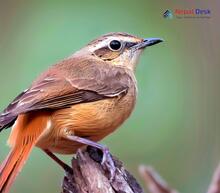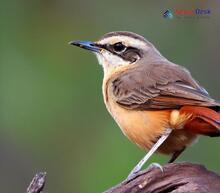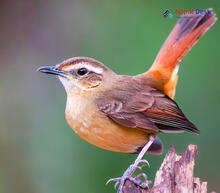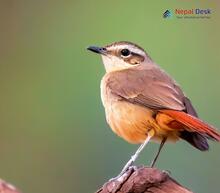The fascinating world of ornithology gives us insights into the diverse avian species across the globe. Among these creatures, the Cercotrichas genus stands out due to its distinct evolutionary history and captivating characteristics. In this article, we will explore the evolution tree, taxonomy, morphology, ecology, and presence of Cercotrichas species in Nepal.
Evolution Tree and Taxonomy
Belonging to the Muscicapidae family, the Cercotrichas genus consists of small passerine birds, often referred to as scrub robins or bush warblers. These captivating birds can be found throughout Africa and some regions of Southeast Asia. Their unique feather patterns range from simple brown or gray to eye-catching black-and-white combinations. This natural camouflage helps them blend into their preferred environments, such as thickets or understories, making it easier for them to remain unseen.
To truly understand the taxonomic context of the Cercotrichas genus, we need to delve into its evolutionary history. Guided by recent molecular research, scientists have gained profound insights into the relationships between various bird genera. The Muscicapidae family consists of over 300 species and is divided into two main clades: Muscicapoidea and Saxicoloidea.
The Muscicapoidea clade encompasses well-known genera like Ficedula (flycatchers), Muscicapa (Old World flycatchers), and Enicurus (forktails). On the other hand, the Saxicoloidea clade mainly includes Luscinia (nightingales), Tarsiger (bush-robins), and Saxicola (stonechats). The Cercotrichas genus belongs to the Saxicoloidea group, holding a vital position concerning evolutionary connections.
As for taxonomy, the Cercotrichas genus includes several notable species divided into ten distinct groups. Some of the most renowned species within this genus are:
1. Cercotrichas quadrivirgata (Eastern Bearded Scrub Robin)
2. Cercotrichas leucophrys (Red-backed Scrub Robin)
3. Cercotrichas galactotes (Rufous-tailed Scrub Robin)
4. Cercotrichas coryphaeus (Karoo Scrub Robin)
It is crucial to document precise evolutionary relationships and taxonomy among bird species for conservation initiatives and continued avian biodiversity research. By understanding the complex connections between various Cercotrichas species and their position within the broader Saxicoloidea clade, scientists can lay a foundation for a more profound knowledge of their biology, ecology, and overall contributions to our planet's natural balance.
Morphological Marvels: Appearance and Characteristics
Species within the Cercotrichas genus possess striking morphological features. These birds are generally small in size, measuring around 14-17 centimeters in length. Their plumage consists of muted browns and grays with streaks or spots that help them blend seamlessly into their environment. Furthermore, they exhibit sexual dimorphism – males tend to boast brighter colors and distinct markings compared to females.
However, it is their unique tail that stands out significantly as a distinguishing feature among this genus. Their elongated outer tail feathers allow them to perform characteristic flicks and display ceremonies appealing to prospective mates or ward off potential threats.
Ecological Expanse: Habitat and Behavior
Cercotrichas birds are primarily found in scrublands, undergrowth in open woodlands, savannas, or forest edges. Their ground-dwelling nature aids them in foraging for food – mainly consisting of insects such as beetles, ants, and termites. One intriguing aspect of their behavior is their agility and swiftness in moving through the undergrowth, enabling them to evade predators successfully.
Nest-building in Cercotrichas species showcases their architectural prowess. These nests are cup-shaped structures often built on or close to the ground, concealed within dense vegetation for added protection.
Presence in Nepal: The Brown Scrub Robin
In Nepal, one can spot a Cercotrichas species known as the Brown Scrub Robin (Cercotrichas signata). This enigmatic bird has been sighted in scattered locations of the southern Terai region, particularly in forest clearings and grassy areas near water sources. Conservationists and ornithologists continue to study its distribution patterns and habitat preferences to ensure proper conservation measures are implemented.
In conclusion, the Cercotrichas genus encompasses a fascinating group of birds, with intriguing evolutionary histories and captivating features. Their presence in Nepal highlights the country's unique biodiversity, showcasing its importance as an ecological niche for such distinct avian species. By studying and understanding these captivating creatures, we enrich our knowledge of nature while ensuring their survival for future generations to admire and appreciate.




